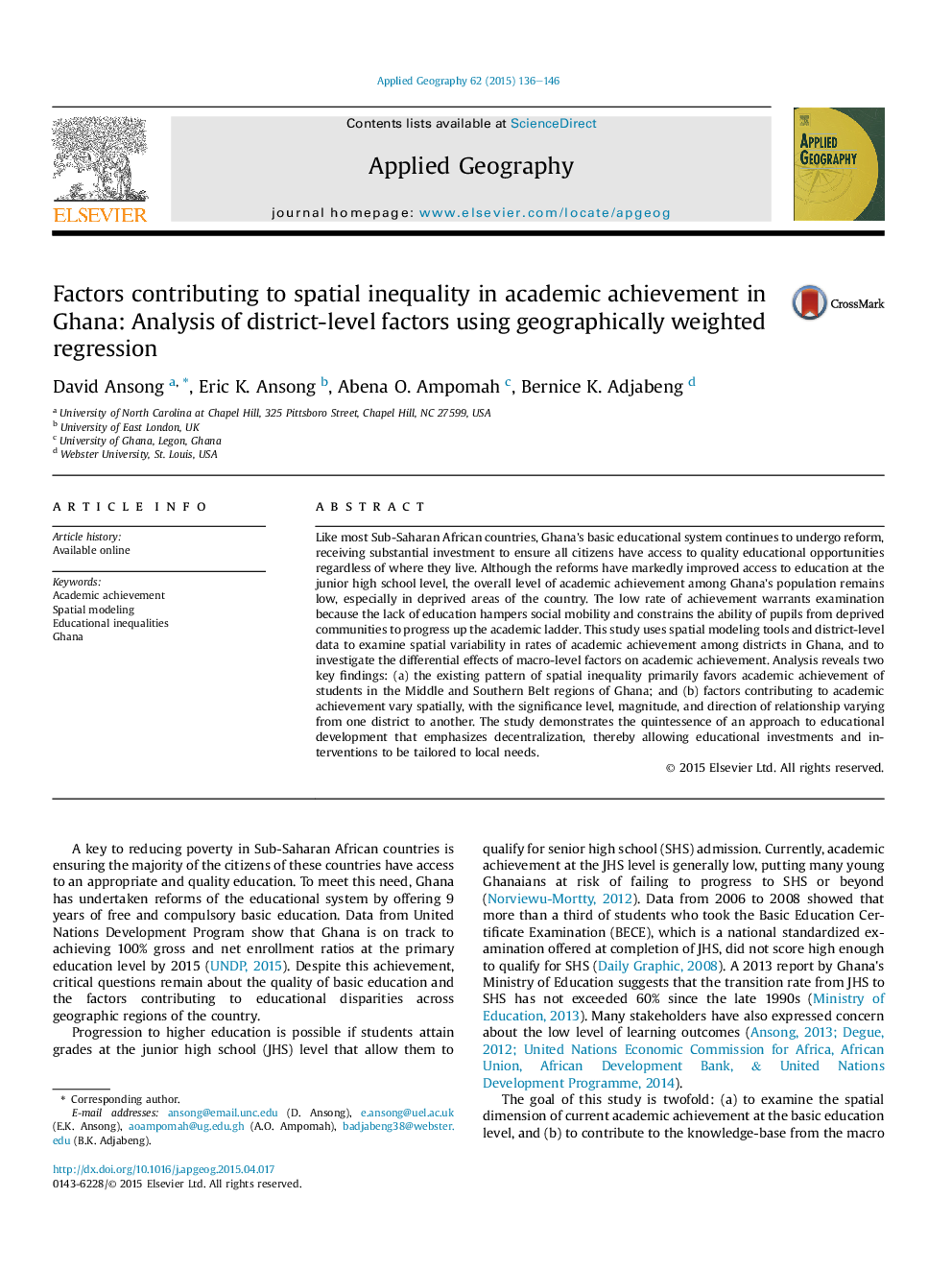| کد مقاله | کد نشریه | سال انتشار | مقاله انگلیسی | نسخه تمام متن |
|---|---|---|---|---|
| 6538501 | 158698 | 2015 | 11 صفحه PDF | دانلود رایگان |
عنوان انگلیسی مقاله ISI
Factors contributing to spatial inequality in academic achievement in Ghana: Analysis of district-level factors using geographically weighted regression
ترجمه فارسی عنوان
عوامل موثر بر نابرابری فضایی در پیشرفت تحصیلی در غنا: تحلیل عوامل منطقه ای با استفاده از رگرسیون وزنی جغرافیایی
دانلود مقاله + سفارش ترجمه
دانلود مقاله ISI انگلیسی
رایگان برای ایرانیان
کلمات کلیدی
دستاوردهای علمی، مدلسازی فضایی، نابرابری آموزشی غنا،
ترجمه چکیده
همانند بسیاری از کشورهای جنوب صحرای آفریقا، سیستم آموزشی اولیه غنا همچنان به اصلاحات ادامه می دهد و سرمایه گذاری های قابل توجهی برای اطمینان از دسترسی همه شهروندان به فرصت های تحصیلی با کیفیت بدون در نظر گرفتن جایگاه آنها دارد. اگر چه اصلاحات به طور قابل توجهی دسترسی به تحصیلات را در سطح دبیرستان بهبود داده است، سطح کلی پیشرفت تحصیلی در میان جمعیت غنا همچنان پایین است، به ویژه در مناطق محروم کشور. کم بودن دستاورد مورد بررسی قرار می گیرد، زیرا عدم آموزش، مانع از تحرک اجتماعی و توانایی دانش آموزان از محروم کردن جوامع است تا پیشرفت نردبان آکادمیک را محدود کند. این مطالعه از ابزارهای مدل سازی فضایی و داده های سطح منطقه ای برای بررسی تنوع فضایی در میزان پیشرفت تحصیلی در مناطق مختلف غنا و همچنین بررسی تاثیرات افتراق عوامل کلان بر پیشرفت تحصیلی استفاده می کند. تجزیه و تحلیل نشان می دهد دو یافته های کلیدی: (الف) الگوی موجود نابرابری فضایی در درجه اول به پیشرفت تحصیلی دانش آموزان در مناطق کمربند خاورمیانه و جنوب غنا کمک می کند؛ و (ب) عواملی که باعث پیشرفت تحصیلی می شوند، فضایی متفاوت با سطح اهمیت، میزان و جهت روابط متفاوت از یک ناحیه به دیگری. این مطالعه نشان می دهد که نگرش رویکرد به توسعه آموزشی که بر تمرکز تمرکز تأکید دارد، به این ترتیب سرمایه گذاری های آموزشی و مداخلات را به نیازهای محلی متصل می کند.
موضوعات مرتبط
علوم زیستی و بیوفناوری
علوم کشاورزی و بیولوژیک
جنگلداری
چکیده انگلیسی
Like most Sub-Saharan African countries, Ghana's basic educational system continues to undergo reform, receiving substantial investment to ensure all citizens have access to quality educational opportunities regardless of where they live. Although the reforms have markedly improved access to education at the junior high school level, the overall level of academic achievement among Ghana's population remains low, especially in deprived areas of the country. The low rate of achievement warrants examination because the lack of education hampers social mobility and constrains the ability of pupils from deprived communities to progress up the academic ladder. This study uses spatial modeling tools and district-level data to examine spatial variability in rates of academic achievement among districts in Ghana, and to investigate the differential effects of macro-level factors on academic achievement. Analysis reveals two key findings: (a) the existing pattern of spatial inequality primarily favors academic achievement of students in the Middle and Southern Belt regions of Ghana; and (b) factors contributing to academic achievement vary spatially, with the significance level, magnitude, and direction of relationship varying from one district to another. The study demonstrates the quintessence of an approach to educational development that emphasizes decentralization, thereby allowing educational investments and interventions to be tailored to local needs.
ناشر
Database: Elsevier - ScienceDirect (ساینس دایرکت)
Journal: Applied Geography - Volume 62, August 2015, Pages 136-146
Journal: Applied Geography - Volume 62, August 2015, Pages 136-146
نویسندگان
David Ansong, Eric K. Ansong, Abena O. Ampomah, Bernice K. Adjabeng,
